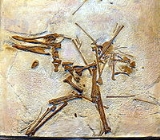
Cycnorhamphus
Encyclopedia

Genus
In biology, a genus is a low-level taxonomic rank used in the biological classification of living and fossil organisms, which is an example of definition by genus and differentia...
of ctenchasmatoid
Ctenochasmatoidea
Ctenochasmatoidea is a group of pterosaurs within the suborder Pterodactyloidea.-Classification:Cladogram after Unwin ....
pterodactyloid
Pterodactyloidea
Pterodactyloidea forms one of the two suborders of pterosaurs , and contains the most derived members of this group of flying reptiles...
pterosaur
Pterosaur
Pterosaurs were flying reptiles of the clade or order Pterosauria. They existed from the late Triassic to the end of the Cretaceous Period . Pterosaurs are the earliest vertebrates known to have evolved powered flight...
from the Late Jurassic
Late Jurassic
The Late Jurassic is the third epoch of the Jurassic Period, and it spans the geologic time from 161.2 ± 4.0 to 145.5 ± 4.0 million years ago , which is preserved in Upper Jurassic strata. In European lithostratigraphy, the name "Malm" indicates rocks of Late Jurassic age...
of France
France
The French Republic , The French Republic , The French Republic , (commonly known as France , is a unitary semi-presidential republic in Western Europe with several overseas territories and islands located on other continents and in the Indian, Pacific, and Atlantic oceans. Metropolitan France...
and Germany
Germany
Germany , officially the Federal Republic of Germany , is a federal parliamentary republic in Europe. The country consists of 16 states while the capital and largest city is Berlin. Germany covers an area of 357,021 km2 and has a largely temperate seasonal climate...
.
In 1855 a fossil
Fossil
Fossils are the preserved remains or traces of animals , plants, and other organisms from the remote past...
in a plate of shale
Shale
Shale is a fine-grained, clastic sedimentary rock composed of mud that is a mix of flakes of clay minerals and tiny fragments of other minerals, especially quartz and calcite. The ratio of clay to other minerals is variable. Shale is characterized by breaks along thin laminae or parallel layering...
from the Tithonian
Tithonian
In the geologic timescale the Tithonian is the latest age of the Late Jurassic epoch or the uppermost stage of the Upper Jurassic series. It spans the time between 150.8 ± 4 Ma and 145.5 ± 4 Ma...
, found near Nusplingen
Nusplingen
Nusplingen is a Swabian town in the Zollernalb district, Baden-Württemberg, Germany.The town is located in the valley of the small river Bära, about 12 miles up-river from where it flows in to the Danube. In the Middle Ages Nusplingen gained the rights of a city...
in Württemberg
Württemberg
Württemberg , formerly known as Wirtemberg or Wurtemberg, is an area and a former state in southwestern Germany, including parts of the regions Swabia and Franconia....
, holotype
Holotype
A holotype is a single physical example of an organism, known to have been used when the species was formally described. It is either the single such physical example or one of several such, but explicitly designated as the holotype...
GPIT "Orig. Quenstedt 1855, Taf. 1", was named Pterodactylus
Pterodactylus
Pterodactylus is a genus of pterosaurs, whose members are popularly known as pterodactyls. It was the first to be named and identified as a flying reptile...
suevicus by Friedrich August Quenstedt.
In 1870 Harry Govier Seeley assigned it to a new genus: Cycnorhamphus. In 1907 however, Felix Plieninger rejected this split, an opinion then shared by most paleontologists. In 1974 Jacques Fabre, when concluding that a new species found and named by him, Gallodactylus canjuersensis, was congeneric with P. suevicus, did not revive Cycnorhamphus, but judged that the latter name was unavailable because of mistakes in the diagnosis by Seeley. P. suevicus thus became Gallodactylus suevicus. However, in 1996 Christopher Bennett pointed out that such mistakes do not invalidate a name and that therefore Cycnorhamphus has priority, making Gallodactylus canjuersensis C. canjuersensis. In 2010, Bennett published further re-study of the fossils, concluding that the differences between the two species could be explained by age, sex or individual variation, and formally synonymized C. canjuersensis and C. suevicus.
Cycnorhamphus had a long beak with teeth only at the tip of its jaws, possibly an adaptation to seek invertebrates in the mud. Its wingspan was about 135 centimetres.

